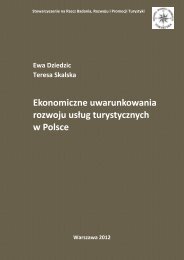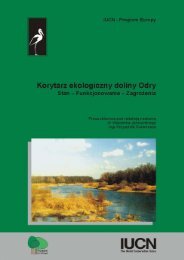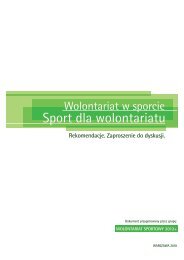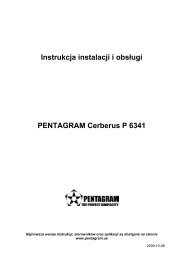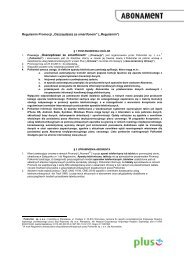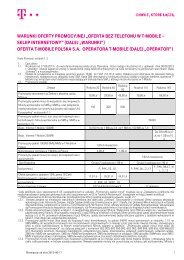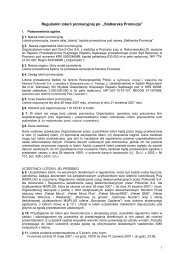- Page 1 and 2:
IUCN - Program Europy Ptaki ³¹k i
- Page 5:
Fundacja IUCN Poland dziêkuje Mini
- Page 8 and 9:
Tereny mokrad³owe w Polsce zajmuj
- Page 10 and 11:
Fundacja IUCN Poland 2.5. £¹ki na
- Page 12 and 13:
Fundacja IUCN Poland 6.3.1. Charakt
- Page 14 and 15:
Fundacja IUCN Poland 11.3. Powierzc
- Page 16 and 17:
Fundacja IUCN Poland 1 2 3 4 5 6 7
- Page 18 and 19:
Fundacja IUCN Poland 12-20 maj, 1
- Page 21 and 22:
2 Pomorze Zachodnie 2.1.Wstêp Lite
- Page 23 and 24:
Pomorze Zachodnie kszyk rycyk kulik
- Page 25 and 26:
Pomorze Zachodnie buteo), orlika kr
- Page 27 and 28:
Pomorze Zachodnie wydaje siê byæ
- Page 29 and 30:
Pomorze Zachodnie Opieki Ptaków (O
- Page 31 and 32:
Pomorze Zachodnie reprezentuj¹cych
- Page 33 and 34:
Pomorze Zachodnie Ro¿eniec (A. acu
- Page 35 and 36:
Pomorze Zachodnie której dwie pary
- Page 37 and 38:
Pomorze Zachodnie cechuj¹ ³agodne
- Page 39 and 40:
Pomorze Zachodnie ¿uraw (Grus grus
- Page 41 and 42:
Pomorze Zachodnie 2.5. £¹ki nad J
- Page 43 and 44:
Pomorze Zachodnie ci¹g dalszy tabe
- Page 45 and 46:
Pomorze Zachodnie cannabina), rzepo
- Page 47 and 48:
Pomorze Zachodnie Kêpy Lubczyñski
- Page 49 and 50:
Pomorze Zachodnie brodziec piskliwy
- Page 51 and 52:
Pomorze Zachodnie Badany fragment
- Page 53 and 54:
Pomorze Zachodnie Tabela 2.7. Chara
- Page 55 and 56:
Pomorze Zachodnie liczebnoϾ tej
- Page 57 and 58:
Pomorze Zachodnie Wyspy zamykaj¹ce
- Page 59 and 60:
Pomorze Zachodnie (A. querquedula),
- Page 61 and 62:
Pomorze Zachodnie Coraz wyraŸniejs
- Page 63:
Pomorze Zachodnie w razie wykupien
- Page 66 and 67:
Fundacja IUCN Poland (koniec maja)
- Page 68 and 69:
Fundacja IUCN Poland Warta Wymys³
- Page 70 and 71:
Fundacja IUCN Poland Ko³o Kol. Pow
- Page 72 and 73:
Fundacja IUCN Poland ci¹g dalszy t
- Page 74 and 75:
Fundacja IUCN Poland ci¹g dalszy t
- Page 76 and 77:
Fundacja IUCN Poland ci¹g dalszy t
- Page 78 and 79:
Fundacja IUCN Poland 3.4. Wstêpna
- Page 80 and 81:
Fundacja IUCN Poland tworzenie dzi
- Page 82 and 83:
Fundacja IUCN Poland srebrzystej (L
- Page 84 and 85:
Fundacja IUCN Poland Stosowano meto
- Page 86 and 87:
Fundacja IUCN Poland ci¹g dalszy t
- Page 88 and 89:
Fundacja IUCN Poland krakwy (A. str
- Page 90 and 91:
Fundacja IUCN Poland K³opotowo. Po
- Page 92 and 93:
Fundacja IUCN Poland Urad Pliszka O
- Page 94 and 95:
Fundacja IUCN Poland ci¹g dalszy t
- Page 96 and 97:
Fundacja IUCN Poland Rybocice. Gatu
- Page 98 and 99:
Fundacja IUCN Poland Krzesin. Gatun
- Page 100 and 101:
Fundacja IUCN Poland niemy (Cygnus
- Page 103 and 104:
5 Dolny Œl¹sk 5.1. Wstêp Œl¹sk
- Page 105 and 106:
Dolny Œl¹sk w³aœciwych (rz¹d P
- Page 107 and 108:
Dolny Œl¹sk Ro¿eniec (Anas acut
- Page 109 and 110:
Dolny Œl¹sk Tabela 5.1. Charakter
- Page 111 and 112:
Dolny Œl¹sk notowano lêgi gêgaw
- Page 113 and 114:
Dolny Œl¹sk na czêœci dawniej i
- Page 115 and 116:
Dolny Œl¹sk Tabela 5.3. Charakter
- Page 117 and 118:
Dolny Œl¹sk Kana³ Pó³nocny Szp
- Page 119 and 120:
Dolny Œl¹sk 5.4.3. Wstêpna ocena
- Page 121 and 122:
Dolny Œl¹sk œci, przez wypalanie
- Page 123 and 124:
Dolny Œl¹sk (Lanius collurio), kr
- Page 125 and 126:
Dolny Œl¹sk Topola Wlk. Janków P
- Page 127 and 128:
Dolny Œl¹sk Kotowice Szewce Panie
- Page 129 and 130:
Dolny Œl¹sk Ponadto na terenie ty
- Page 131 and 132:
Dolny Œl¹sk skiej, ale nale¿a³o
- Page 133:
Dolny Œl¹sk 5.8.3. Wstêpna ocena
- Page 136 and 137:
Fundacja IUCN Poland jednak z s¹si
- Page 138 and 139:
Fundacja IUCN Poland torfowisko wra
- Page 140 and 141:
Fundacja IUCN Poland licz¹ce 132 s
- Page 142 and 143:
Fundacja IUCN Poland Strumieniówk
- Page 144 and 145:
Fundacja IUCN Poland * * derkacz zi
- Page 146 and 147:
Fundacja IUCN Poland acutiformis).
- Page 148 and 149:
Fundacja IUCN Poland wowy (Circus a
- Page 150 and 151:
Fundacja IUCN Poland nienia ¿urawi
- Page 152 and 153:
Fundacja IUCN Poland ³¹k, na wyso
- Page 154 and 155:
Fundacja IUCN Poland Dziœ Staœwi
- Page 156 and 157:
Fundacja IUCN Poland Wiosenne stada
- Page 158 and 159:
Fundacja IUCN Poland ci¹g dalszy t
- Page 160 and 161:
Fundacja IUCN Poland (Turdus merula
- Page 162 and 163:
Fundacja IUCN Poland Klon. Wykaz ga
- Page 164 and 165:
Fundacja IUCN Poland jako ¿erowisk
- Page 166 and 167:
Fundacja IUCN Poland w³asnoœci, i
- Page 168 and 169:
Fundacja IUCN Poland zamiana trwa³
- Page 170 and 171:
Fundacja IUCN Poland znajduj¹ siê
- Page 172 and 173:
Fundacja IUCN Poland 7.2.3. Wyniki
- Page 174 and 175:
Fundacja IUCN Poland zaniepokojon¹
- Page 176 and 177:
Fundacja IUCN Poland tu bataliony (
- Page 178 and 179:
Fundacja IUCN Poland wahaniom, co w
- Page 180 and 181:
Fundacja IUCN Poland go Parku Narod
- Page 182 and 183:
Fundacja IUCN Poland 1276 ha. Admin
- Page 184 and 185:
Fundacja IUCN Poland ci¹g dalszy t
- Page 186 and 187:
Fundacja IUCN Poland Zajki. Na powi
- Page 188 and 189:
Fundacja IUCN Poland ci¹g dalszy t
- Page 190 and 191:
Fundacja IUCN Poland ci¹g dalszy t
- Page 192 and 193:
Fundacja IUCN Poland 8 samców, a w
- Page 195 and 196:
8 Mazowsze 8.1. Wstêp W œrodkowo-
- Page 197 and 198:
Mazowsze 7,1 km 2 i w przewa¿aj¹c
- Page 199 and 200:
Mazowsze erythrinus) jak te¿ gatun
- Page 201 and 202:
Liwiec Mazowsze i torfowiska najlic
- Page 203 and 204:
Mazowsze Tabela 8.1. Charakterystyk
- Page 205 and 206:
Mazowsze arvensis) i g¹siorek (Lan
- Page 207 and 208:
Mazowsze Tabela 8.4. Zmiana liczebn
- Page 209 and 210:
Mazowsze Binduga D³ugie Bandysie P
- Page 211 and 212:
Mazowsze nie s¹ równie¿ zagro¿o
- Page 213 and 214:
Mazowsze Kopaczyska Nadlesie Kierze
- Page 215 and 216:
Mazowsze Ma³kinia Grn. Glina Podg
- Page 217 and 218:
Mazowsze œpiewak (T. philomelos),
- Page 219 and 220:
Mazowsze zbo¿owych (Circus cyaneus
- Page 221 and 222:
Mazowsze Tabela 8.12. Charakterysty
- Page 223 and 224:
Mazowsze Tabela 8.14. Porównanie t
- Page 225 and 226:
Mazowsze nych powierzchni nie spe³
- Page 227:
Mazowsze 11. Zakaz usuwania istniej
- Page 230 and 231:
Fundacja IUCN Poland B³ota Brudze
- Page 232 and 233:
Fundacja IUCN Poland Batalion (Phi
- Page 234 and 235:
Fundacja IUCN Poland W granicach ba
- Page 236 and 237:
Fundacja IUCN Poland niami zagro¿e
- Page 238 and 239:
Fundacja IUCN Poland 9.2.4. Zagro¿
- Page 240 and 241:
Fundacja IUCN Poland nym olsie. Kor
- Page 242 and 243:
Fundacja IUCN Poland mucho³ówka s
- Page 244 and 245:
Fundacja IUCN Poland Domaniewice Ro
- Page 246 and 247:
Fundacja IUCN Poland w kierunku prz
- Page 248 and 249:
Fundacja IUCN Poland Tabela 9.6. Ch
- Page 250 and 251:
Fundacja IUCN Poland w formie parku
- Page 252 and 253:
Fundacja IUCN Poland Ponadto na oma
- Page 254 and 255:
Fundacja IUCN Poland 9.7.2. Wyniki
- Page 256 and 257:
Fundacja IUCN Poland zach, zaœmiec
- Page 258 and 259:
Fundacja IUCN Poland (Phylloscopus
- Page 260 and 261:
Fundacja IUCN Poland Borzykowa Puka
- Page 262 and 263:
Fundacja IUCN Poland Ze wzglêdu na
- Page 264 and 265:
Fundacja IUCN Poland pokrywa natomi
- Page 266 and 267:
Fundacja IUCN Poland W okresie wêd
- Page 268 and 269:
Fundacja IUCN Poland Niemniej jedna
- Page 270 and 271:
Fundacja IUCN Poland z osuszaniem w
- Page 272 and 273:
Fundacja IUCN Poland daje szacunkow
- Page 274 and 275:
Fundacja IUCN Poland Pojezierza £
- Page 276 and 277:
Fundacja IUCN Poland 10.4.2. Wyniki
- Page 278 and 279:
Fundacja IUCN Poland Zielonka (Por
- Page 280 and 281:
Fundacja IUCN Poland kosa (Turdus m
- Page 282 and 283:
Fundacja IUCN Poland Niebezpiecznym
- Page 284 and 285:
Fundacja IUCN Poland Niecka Nidzia
- Page 286 and 287:
Fundacja IUCN Poland pratense), tom
- Page 288 and 289:
Fundacja IUCN Poland pnia, ¿e hekt
- Page 290 and 291:
Fundacja IUCN Poland ci¹g dalszy t
- Page 292 and 293:
Fundacja IUCN Poland Bocian czarny
- Page 294 and 295:
Fundacja IUCN Poland Tabela 11.2. C
- Page 296 and 297:
Fundacja IUCN Poland w Niecce, 88 w
- Page 298 and 299: Fundacja IUCN Poland czêœæ zosta
- Page 300 and 301: Fundacja IUCN Poland Bielany Bodzó
- Page 302 and 303: Fundacja IUCN Poland 5 m, jednak¿e
- Page 304 and 305: Fundacja IUCN Poland wody. Na pó³
- Page 306 and 307: Fundacja IUCN Poland przyrodniczo f
- Page 308 and 309: Fundacja IUCN Poland carduelis), ma
- Page 310 and 311: Fundacja IUCN Poland kruk (Corvus c
- Page 312 and 313: Fundacja IUCN Poland 11.3.3. Wstêp
- Page 314 and 315: Fundacja IUCN Poland wo dominowa³y
- Page 316 and 317: Fundacja IUCN Poland £¹ki Królew
- Page 318 and 319: Fundacja IUCN Poland wojewódzkie d
- Page 321 and 322: 12 Podsumowanie 12.1. Gatunki lêgo
- Page 323 and 324: Podsumowanie Tabela 12.2. Liczba pa
- Page 325 and 326: Podsumowanie Tabela 12.5. Zagêszcz
- Page 327 and 328: Podsumowanie 12.3. Zagro¿enia osto
- Page 329 and 330: 13 Piœmiennictwo Adamski A., Czapu
- Page 331 and 332: Piœmiennictwo Denisiuk Z. 1976. £
- Page 333 and 334: Piœmiennictwo Jermaczek A., Czwa³
- Page 335 and 336: Piœmiennictwo Miara E., Weso³owsk
- Page 337: Piœmiennictwo Sumieñ T., Platz H.
- Page 340 and 341: Fundacja IUCN Poland 2.5. Meadows a
- Page 342 and 343: Fundacja IUCN Poland 6.3.1. Charact
- Page 344 and 345: Fundacja IUCN Poland 11.3. Research
- Page 346 and 347: Fundacja IUCN Poland 2. Selection o
- Page 350 and 351: Fundacja IUCN Poland surface-feedin



![PENTAGRAM Cerberus [P 6367] Installation and Operation Manual](https://img.yumpu.com/49786948/1/184x260/pentagram-cerberus-p-6367-installation-and-operation-manual.jpg?quality=85)
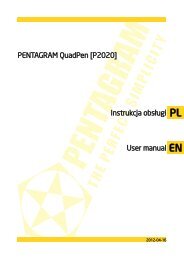
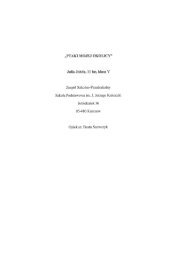

![PENTAGRAM Cerberus [P 6361] Quick Guide](https://img.yumpu.com/43449286/1/185x260/pentagram-cerberus-p-6361-quick-guide.jpg?quality=85)

